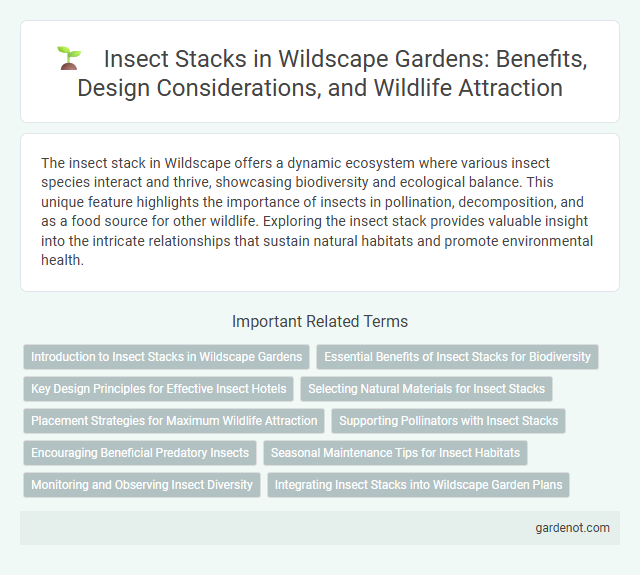The insect stack in Wildscape offers a dynamic ecosystem where various insect species interact and thrive, showcasing biodiversity and ecological balance. This unique feature highlights the importance of insects in pollination, decomposition, and as a food source for other wildlife. Exploring the insect stack provides valuable insight into the intricate relationships that sustain natural habitats and promote environmental health.
Introduction to Insect Stacks in Wildscape Gardens
In Wildscape Gardens, insect stacks serve as vital habitats designed to attract and support diverse pollinators and beneficial insects such as ladybugs, bees, and lacewings. These structured refuges contribute to pest control and promote biodiversity by providing shelter, breeding sites, and food resources. Incorporating insect stacks enhances ecosystem balance and encourages natural pest management within garden landscapes.
Essential Benefits of Insect Stacks for Biodiversity
Insect stacks play a crucial role in enhancing biodiversity by providing essential habitats and nesting sites for various pollinators and decomposers. These structures support ecosystem balance through promoting insect population diversity, which directly contributes to soil health and plant pollination. Incorporating insect stacks into wildscapes fosters resilient ecosystems by sustaining key species that drive natural processes.
Key Design Principles for Effective Insect Hotels
Insect hotels designed using key principles such as habitat diversity, material variety, and structural stability promote thriving insect populations and biodiversity. Incorporating natural elements like hollow stems, pine cones, and untreated wood mimics insects' natural environments, enhancing shelter and breeding opportunities. Proper orientation and protection from extreme weather ensure increased occupancy and support ecological balance within the Wildscape ecosystem.
Selecting Natural Materials for Insect Stacks
Selecting natural materials such as dried leaves, twigs, bark, and hollow stems is essential for building effective insect stacks that mimic natural habitats. These components provide shelter and breeding grounds for beneficial insects like ladybugs, solitary bees, and beetles, enhancing biodiversity in wildscapes. Using untreated wood and organic debris ensures a chemical-free environment, promoting healthy insect populations and supporting ecosystem balance.
Placement Strategies for Maximum Wildlife Attraction
Insect stacks should be strategically placed near diverse native vegetation to maximize wildlife attraction, especially pollinators and beneficial insects. Positioning stacks at varying heights between 1 to 3 meters enhances accessibility for different species while ensuring shelter from harsh weather conditions. Choosing south-facing locations with ample sunlight increases insect activity, promoting a thriving ecosystem within the Wildscape.
Supporting Pollinators with Insect Stacks
Insect stacks provide essential habitats that support pollinators such as bees, butterflies, and hoverflies by offering shelter, breeding sites, and nectar sources in Wildscape environments. These structures enhance biodiversity and promote the health of pollinator populations, which are crucial for ecosystem balance and crop pollination. Integrating insect stacks into Wildscape designs increases pollination efficiency and helps sustain local flora diversity.
Encouraging Beneficial Predatory Insects
Encouraging beneficial predatory insects in Wildscape habitats significantly enhances natural pest control, promoting ecosystem balance and biodiversity. Techniques such as planting native flowering species and providing sheltered microhabitats support populations of ladybugs, lacewings, and predatory beetles. These insects reduce reliance on chemical pesticides, fostering a healthier environment and sustainable pest management.
Seasonal Maintenance Tips for Insect Habitats
Seasonal maintenance of insect habitats in Wildscape involves regular removal of debris and dead plant matter to prevent mold growth and promote a healthy ecosystem. Monitoring moisture levels and adjusting watering schedules ensures optimal humidity, especially during dry or wet seasons. Replenishing native plants and flowers each season supports diverse insect populations by providing continuous food and shelter.
Monitoring and Observing Insect Diversity
Insect stacks serve as vital tools for monitoring and observing insect diversity within wildscapes by providing structured habitats that attract various species for study. These stacks facilitate data collection on insect behavior, population dynamics, and ecological interactions, which are essential for biodiversity assessments and conservation efforts. Continuous observation through insect stacks supports understanding of species richness and habitat health in natural ecosystems.
Integrating Insect Stacks into Wildscape Garden Plans
Integrating Insect Stacks into Wildscape garden plans enhances biodiversity by providing essential habitats for pollinators and beneficial insects. These modular insect habitats support population growth of native species, promoting natural pest control and improving overall plant health. Incorporating insect stacks strategically within the garden fosters ecological balance and contributes to a sustainable, thriving wildscape environment.
Insect stack Infographic

 gardenot.com
gardenot.com